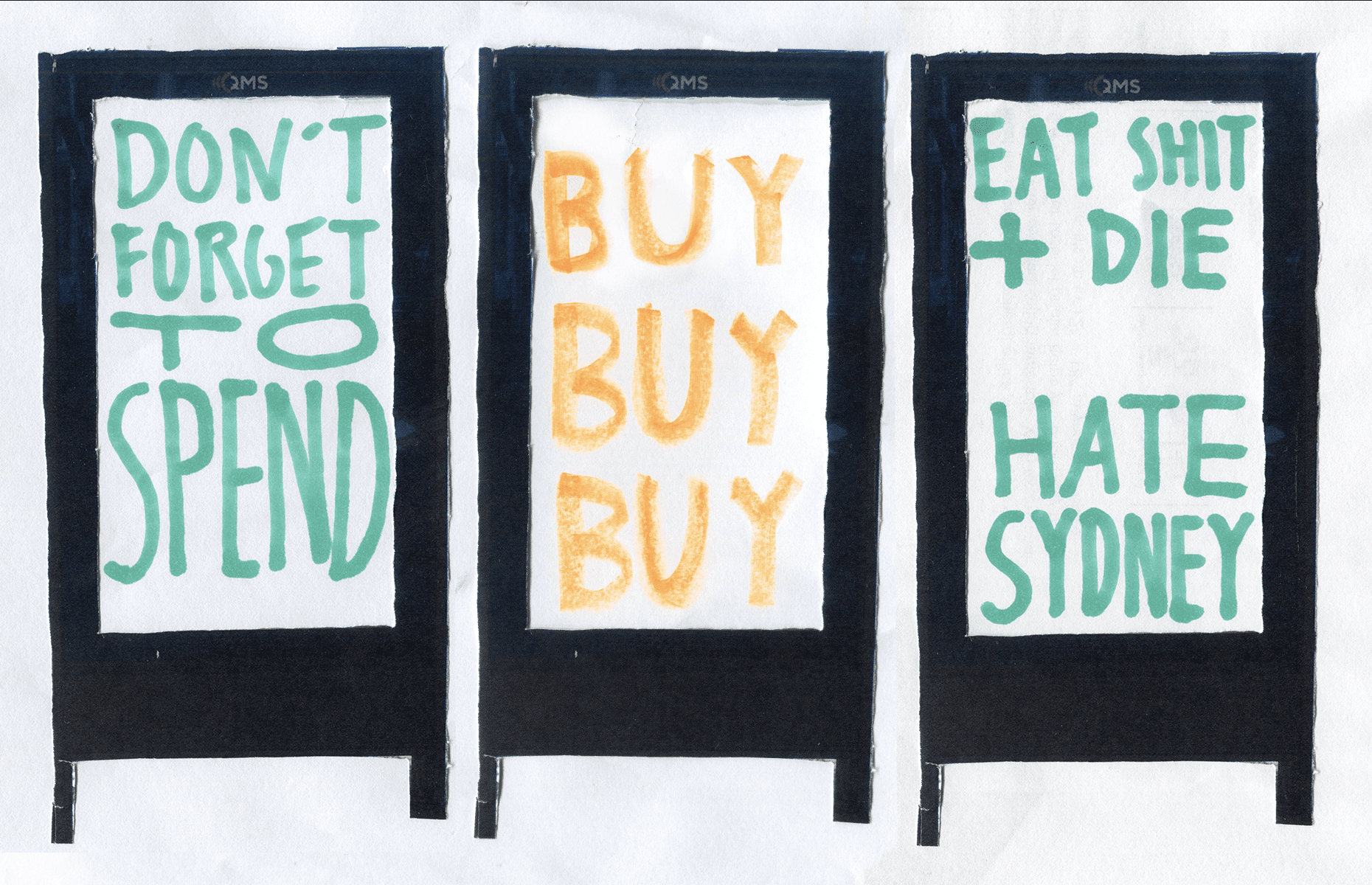Advertisements are visual pollution. The pressure to turn a profit can create the disappointing surprise of opening a formerly reliable website only to be met with endless pop-ups, sidebar ads, and auto-play videos. Luckily, it is easy to install ad blocking software, or better yet, close the site. But what can you do when this process occurs across an entire city?
Sydney city residents have likely noticed the new variety of street furniture that has spread through the streets like a cancer. At USyd’s City Road bus stop, students will be familiar with the new and improved bus shelters. By improved, of course, I only refer to its advertisement capabilities. Each bus shelter across the entire City of Sydney has been (or is still in the process of being) replaced with new structures that have near-identical shelter coverage and seating, but are fitted with state-of-the-art digital displays.
The impetus for this refresh has been the tender of City of Sydney’s street furniture contract, with the process to choose a new vendor lasting from 2017 until early 2020. Former contract holder JCDecaux ultimately lost the bid, with newcomer QMS Media paying $420 million for the opportunity to take over operations. Consequently, over 2500 pieces of street furniture, including bus shelters, bins, payphones, and street vendor kiosks, became obsolete overnight.
The major benefit of this contract for the City of Sydney is, of course, financial. A City of Sydney spokesperson told Honi, “revenue from advertising will allow the City to offset ongoing maintenance costs for the community facilities, including bus shelters and automatic public toilets.” Responsibility for maintenance and cleaning falls to QMS as the operator.
After a fresh install, the screens display a welcome message for passers-by who may be curious or horrified by the new street furniture. The message includes the passage, “This transformation will make our streets more functional, sustainable, and accessible for more people to enjoy.” Let’s break that promise down.
The functionality of these screens for the general public is next to nil. When was the last time you waited for a bus and wished that you were being marketed to? According to the council, these screens allow them “to share real-time event information and important public messaging.” I am yet to see a single bus stop display something useful such as, perhaps, a services schedule.
The part of this contract that I find most affronting is the standalone advertisement screens. Located on former payphone sites across the city are what the council describes as “160 sleek new communication pylons… replacing screens that were formerly placed on large Telstra payphones.” I disagree that the former presence of a payphone is justification for an 86 inch LED screen in the middle of a footpath. Their presence stands in stark contrast with the growing pedestrianisation of the CBD driven by Lord Mayor Clover Moore.
One side of these communications pylons display information from the City of Sydney, directing residents to information regarding cycle paths, upcoming events, and the Country they are located on. However, the ratio of advertisements to public service information is severely disproportionate, as I can safely say that across Sydney I’ve seen more ads for Prada or Stan Originals than public information. One side of these pylons are reserved for City of Sydney messaging, with the other side (as well as both sides of every bus stop) reserved for advertisers. The council is able to purchase extra space on this side. As each screen across the city displays different messaging depending on time and location, it is difficult to pin down the exact ratio.
This feature is the true functionality of these screens. QMS Media screens are “powered by intelligent data sets that connect brands to the right consumers — at the right time”. Despite the absence of cameras or facial recognition, according to the Sydney Morning Herald, they do consider information such as GPS, audience profiling, weather data, and Visa spending. The functionality of this new street furniture is not to foster a better rested or informed public, but one more effectively marketed to.
Regarding the second claim of sustainability, I remain unconvinced that ripping up 340 functional bus shelters in the name of improved digital advertising is sustainable. According to Australia’s 2020 National Waste Report, approximately 44% of our total annual waste is construction and demolition-related. The always-on screens are renewably-powered through offsets with the government’s GreenPower scheme, and are constructed with “responsibly sourced materials” according to QMS. Considering this, I refer to an oft-cited quote from American architect Carl Elefante — “the greenest building is the one that already exists.”
QMS’s third claim of ‘accessibility’ is its most damning, with their construction having already presented major issues. Despite being slated for completion in January of this year, at least 90 bus shelters are still under construction eight months later. The lack of bus shelters has left me and plenty of other commuters showing up to work and classes completely drenched over the past year.
While the new shelters should be praised for now meeting disability access requirements, the length of time that Sydney residents have been left without seating, shelter, or public toilets has been unacceptable.
“Live, Work, Play – LOVE Sydney” read the QMS Media vans sent to maintain the new public furniture. I think whoever approved this contract hates Sydney.





